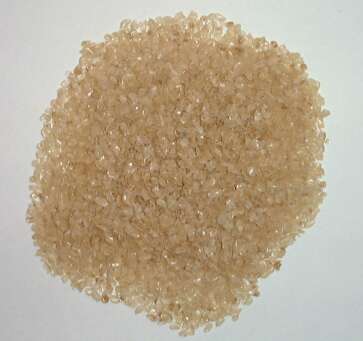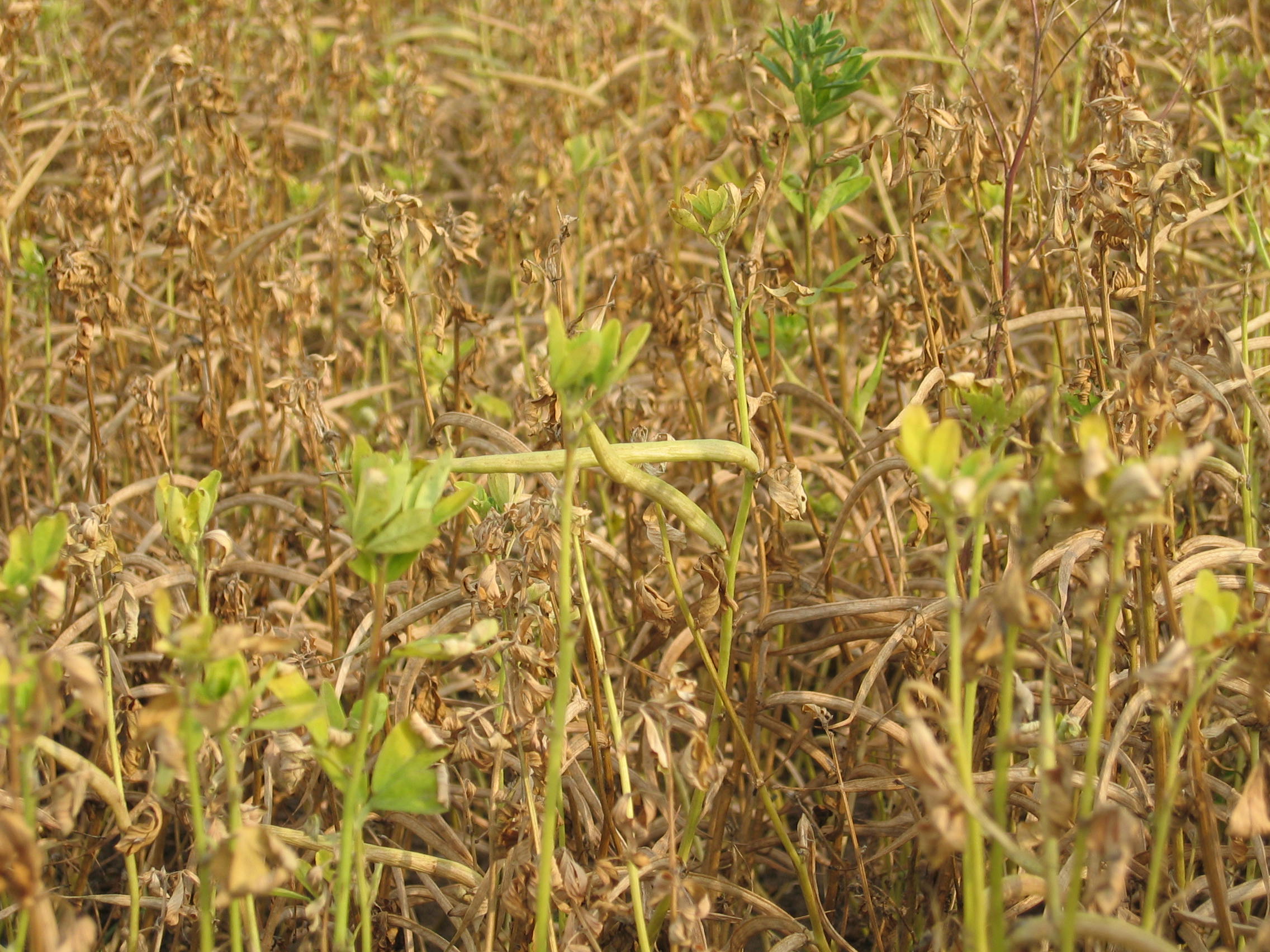- Fenugreek

"Fenugreek" may be unfamiliar to you, but once you smell it, you will realize that it is familiar to you. Yes. Fenugreek is one of major ingredients of curry and produces an aroma of curry.
Fenugreek, Trigonella foenum-graecum, is an annual legume native to the Mediterranean region. From ancient days, it has been grown in the Near and Middle East, Africa, and India and used for food and the medicine purposes. Today it is grown all over the world. It grows straight up to 60cm in height branching off with trefoil leaves and little white flowers. Growing more, it produces sickle shaped pods containing 10 to 20 brownish diamond-shaped seeds which have a diameter of 3 to 4mm and a deep groove in the middle.
Though curry is very popular, Fenugreek is not cultivated in Japan. Still, it has a Japanese name "Koroha" taken from a Chinese name.
In the Near and Middle East, Africa, and India, they eat it in many ways. They eat beansprouts and grown-up fenugreek. It has the same constitution as a soybean, and they feed it to cattle. However, fenugreek is mostly used as beans for curry spice and also used for Indian popular condiment, "chutney". Traditionally, fenugreek has been used in folk medicine for tonic, nutrition, appetizer, and antifebrile. Especially in India and the Near and Middle East, they have the custom that women in the lactation period eat fenugreek because fenugreek is thought to increase their milk. Recently, in Europe and America, many women eat them as health food to enlarge their breasts. Because it is said that steroid saponin contained in fenugreek testa is a precursor of female hormone and it is turned into female hormone in the body that enlarges breast and increases milk.
Close this description
- Fenugreek Gum

The main component in albumen is galactomannan. Galactomannan is a polysaccharide made of galactose combined with mannan, high molecular compound of mannose. Starch is a polymer molecule made of glucose and nutritious, on the other hand mannan made of mannose cannot be digested and is not nutritious. However, galactomanna makes a great contribution to our food.
Galactomannan has a property of increasing viscosity when dissolved in the water and it is useful for forming. If galactomannan is added to milk, it will be ice cream, if added to cocoa, it will be chocolate, and if added to wheat flour, we can make firm noodle. We call the material increasing viscosity when dissolved in the water a gum.
Guar gum and Locust bean gum are also made of galactomannan and used as a gum. Like fenugreek, these gums are taken from legumes, but they have a different property from fenugreek. This difference is originated from the difference of a chemical structure. The ratio of galactose to mannose for fenugreek is 1:1, but for Guar gum, it is 1:2, and for Locust bean gum, it is 1:4.
The less the rate of galactose becomes, the less the solubility becomes. 100% pure mannan without galactose is completely insoluble in water. That is because a chain of galactose prevents becoming insoluble by extending a macromolecule of mannan. So, fenugreek gum containing more galactose has superior solubility and dispersiveness and forms stable colloid for a long time compared to Guar gum and Locust bean gum. If an electrolyte is added to, its viscosity is weakened a little, but if pH is changed, it is stable and has no change in viscosity. Galactose is hydrophilic and mannan is hydrophobic. This means that fenugreek gum is surface-active, in other words, an emulsifier that mixes water and oil. It dissolves oil into water, increases viscosity, and forms aqueous colloids. That moderately disperses oil particles and prevents from sticking to each other, therefore it can maintain the state of oil dispersion. This kind of material is called a stabilizer. Fenugreek galactomannan works as a gum and an emulsifier, so that it can be used as a stabilizer for food.
Thus, fenugreek gum has superior characteristics compared to other conventional gums. Interestingly, the higher the ratio of galactose is, the stronger the effect of lowering the level of sugar and cholesterol in the blood becomes. That is, fenugreek is a medicinal natural food additive.
Fenugreek's medicinal virtues
It has been used as a folk medicine since ancient days, and the reason why it has recently attract particular attention is its effect on diabetes.
It has been confirmed by animal experiments and clinical tests on humans that ingesting the food compounded fenugreek gum powder certainly lowers the level of sugar in the blood for the past few years. Moreover, it has been proved that fenugreek seeds lowers the level of cholesterol and fat in the blood and restrains biosynthesis of cholesterol in the liver. The results of many researches have discovered that these effects are caused by galactomannan contained in albumen in seeds (fenugreek gum). Polysaccharide, or dietary fiber, generally has the effect of lowering the lovel of cholesterol, and fenugreek is distinctive for having the effect of lowering the level of sugar in the blood as well.
When used for diabetes and hypercholesterolemia, it has been proved that the more fenugreek seeds they take, the more the effect they can get. However, it was difficult to take much seed powder because it has a bitter taste and a peculiar smell. We, Air Green, have succeeded in abstracting only albumen from seeds containing 25% of albumen, and then produced fenugreek gum powder. It has no taste and no smell because it does not contain testa which has a bitter taste and a peculiar smell, so everyone can eat it. We have also succeeded in purifying gum powder and abstracting only fenugreek galactomannan without taste and smell.
Intake of Fenugreek Gum
There is no limit for the intake because fenugreek gum is harmless. According to clinical tests, 1.25g of gum (5g in seeds) is enough to lower the blood sugar level and cholesterol. There is a case that 7.25g of gum (30g in seeds) are taken for therapeutic purposes. Generally, it is thought to be effective to take approximately 6g in gum powder or approximately 5g in refined gum powder whose galactomannan content is more than 80%. It is confirmed by animal experiments that administration of the amount equivalent to 120g per day for human does no harm.
Mechanisim of action of Galactomannan
Animal tests have proved that galactomannan blocks intestinal abosorption of glucose. However, the reason is unknown why intaking galactomannan indigestible for human lowers the level of cholesterol in blood and also lowers biosynthesis of cholesterol in the liver. In general, it is said that the action of dietary fiber which increases intestinal viscosity, absorbs cholesterol, and eliminates it as bowel movement reduces the absorption of cholesterol and lowers the level of cholesterol in blood. It is, however, unexplainable why biosynthesis of cholesterol is also lowered.
Some say that galactomannan is aliment for enteric bacteria which decompose glucose into volatile fatty acid so that the absorption of sugar is reduced and fatty acid is absorbed into blood that prevents biosynthesis of cholesterol. Others say that galactomannan causes intestinal canal wall to secrete more hormones and enzymes, and they affect biosynthesis of cholesterol in the liver and the absorption of sugar. But the mechanism has not been fully understood yet. It is certainly possible that bacteria bred by galactomannan have a meaningful relation to these effects, like oligosaccharide breeds Lactobacillus bijidus.
Other effects by fenugreek gum
Because fenugreek galactomannan is dietary fiber, it has an effect as bulk cathartic, so that it works well for constipation. Moreover, it lowers not only cholesterol but also blood fat such as triglyceride. In various experiments designed to determine the effect of lowering blood sugar, weight loss is also observed. This indicates that long-term intake of fenugreek gum loses weight, so you can make diet foods by compounding it into various foods.
Close this description
- Fenugreek gum [Air Green]
Fenugreek gum [Air Green] has three grades, Gum T, Gum A, and Gum B. These grades have different galactmannan content. Gum T contains over 86% of galactmannan, Gum A contains over 80-86% of galactomannan, Gum B contains 60-80% of galactomannan.
When Gum T and A dissolves in water, odorless translucent white gel occurs, and its taste is like cereal. When you use it as a viscous agent, we recommend that you use Gum T and A. Gum B are by-products of Gum T and A, which still have a faint curry smell and are more yellowish brown than Gum A. But if you use it for the things not to be dissolved in water like health supplements, tablets, and capsules. The use of Gum B is recommended because they are cheaper than Gum T and A. Gum T is purest gum and is used for cosmetic raw material.
Specification of Fenugreek Gum
Close this descriptionDescription: Gum powder H: White or slight yellowish powder with a slight original smell.
Gum powder A: light yellowish powder with a slight original smell.
Gum powder B: light brownish powder with a slight curry smell.Identification: When dissolved in the water, it gains viscosity and become jelly solution. Purity test: 1. Acid insoluble matter: Gum powder H and A: not more than 3%
Gum powder B: not more than 5%2. Water insoluble matter: Gum powder H and A: not more than 3%
Gum powder B: not more than 5%3. Heavy metal: not more than 20ppm (as lead) 4. Arsenic: not more than 2ppm Loss on drying: not more than 10% Viscosity (1w/v% solution, 25 C degree): Gum powder H: not less than 3400Pa.s
Gum powder A: not less than 3000Pa.S
Gum powder B: not less than 1000Pa.SGranularity: Gum powder H and A: Not more than 70 mesh
Gum powder B: Not more than 100 meshiNutritional test: 1. Protein: Not more than 5% 2. Starch: negative 3. Fat: not more than 1% 4. Fiber: Gum powder H: not less than 86%
Gum powder A: not less than 80%
Gum powder B: not less than 70%5. Calorie: Not more than 1kcal/g Ash: Not more than 1.5% Assay: Galactomannan Gum powder H: not less than 86%
Gum powder A: not less than 80%
Gum powder B: not less than 60%Microbiological test: (1) General Bacteria: bacteria: not more than 3 x 102
Fungi: not more than 3 x 102(2) E. Coli: negative
- Contact us(E-mail)
If you have some questions about fenugreek or need samples, please feel free to ask us.
- Fenugreek Catalog(PDF:4.38MB)

